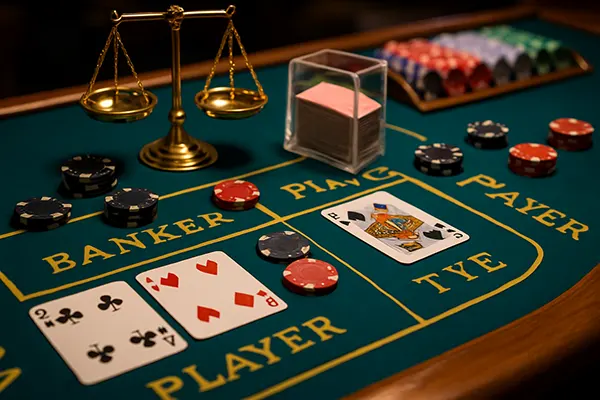
The Mathematics of Baccarat Betting: Can You Beat the House Edge?
Baccarat remains one of the most mathematically intriguing casino games, attracting both casual players and analytical minds. Its reputation for simplicity hides a deep mathematical structure that defines every decision, bet, and outcome. Understanding this structure is the first step in recognising why the house always holds a slight advantage — and whether that edge can ever truly be overcome.
Understanding the Mathematical Foundation of Baccarat
Baccarat is fundamentally a game of probability. Each round involves comparing the hands of the Player and the Banker, with outcomes determined by fixed drawing rules. There are only three main bets available: Player, Banker, and Tie. Although this simplicity appears to favour the player, each bet carries a predefined statistical expectation calculated from thousands of simulated hands.
The Banker bet statistically offers the best return, with a house edge around 1.06%. The Player bet follows closely with a 1.24% edge, while the Tie bet, often considered tempting due to its high payout, carries a significant disadvantage at roughly 14.36%. These figures illustrate that even though baccarat may seem fair, the long-term probabilities always lean towards the house.
From a mathematical perspective, these edges are not arbitrary. They emerge from the deck composition, drawing rules, and the total number of outcomes. Advanced simulations and combinatorial analysis confirm that even with perfect play, the expected value remains slightly negative for the player over time.
The Role of Probability and Expected Value
Every baccarat hand can be expressed in terms of expected value — the average return per unit bet. When a player wagers on the Banker, the theoretical return is approximately 98.94%, meaning that for every 100 units wagered, the expected loss is just over one unit. This small yet consistent advantage ensures the casino’s profitability across millions of rounds.
Understanding expected value helps explain why “streak” betting systems or progressive strategies fail to change the underlying mathematics. No matter how many times one doubles or shifts wagers, the long-term expected value remains negative. The law of large numbers guarantees that actual results will align closely with these probabilities as the number of rounds increases.
Therefore, while luck may temporarily swing the outcome in a player’s favour, mathematics eventually prevails. Baccarat rewards short-term variance but always converges toward its statistical mean, which keeps the house slightly ahead.
Analysing Betting Systems and Their Effectiveness
Various baccarat betting systems — such as the Martingale, Fibonacci, and Paroli — are designed to exploit streaks or compensate for losses. While these methods can influence short-term results, none can alter the mathematical expectation of each bet. The fundamental probabilities governing baccarat remain constant regardless of bet size or sequence.
The Martingale, for example, involves doubling bets after every loss to recover previous losses plus a small profit. Although it may appear logical, it assumes unlimited funds and table limits that do not exist in reality. Eventually, an extended losing streak will exceed available bankroll or maximum bet limits, resulting in inevitable losses.
Progressive systems like Paroli or Fibonacci focus on amplifying wins rather than chasing losses. They provide a more controlled risk approach but still rely entirely on random outcomes. Statistical analysis confirms that no progression system has ever been proven to generate consistent profits against the established house edge.
Simulation Studies and Real-World Data
Modern computer simulations using millions of hands demonstrate that all known betting systems in baccarat fail to outperform flat betting. The expected return remains unchanged, and any perceived advantage is typically the result of short-term variance. This reinforces that mathematics, not betting rhythm, determines long-term results.
In real-world casino conditions, factors such as commission fees on Banker bets further stabilise the house edge. The 5% commission ensures the casino maintains profitability even when players predominantly choose the statistically superior bet. Over time, this adjustment keeps the balance firmly in favour of the house.
These data-driven findings confirm that while strategy and discipline can enhance bankroll management, they cannot modify the core probabilities that shape baccarat outcomes.

The Future of Baccarat Strategy in a Data-Driven Era
Technological advancements and data analytics have brought new approaches to understanding baccarat. Software and AI models now track betting patterns and card sequences in real time, but even these tools cannot escape the fundamental mathematics of the game. Baccarat remains governed by probability, not prediction.
However, data analytics does serve a valuable purpose in bankroll control and risk analysis. By calculating variance and return distribution, players can manage exposure and set rational expectations. While this doesn’t overturn the house edge, it allows for smarter decision-making based on empirical evidence rather than superstition.
As casinos increasingly adopt algorithmic monitoring, the game continues to evolve, but its mathematical balance remains intact. Baccarat’s enduring appeal lies in its equilibrium — a contest of chance that no formula has yet been able to defeat.
Practical Insights for Analytical Players
For those who approach baccarat as a mathematical exercise, understanding risk tolerance is more valuable than chasing illusions of profit. Keeping bets consistent, focusing on low-edge options, and avoiding the Tie bet are practical applications of probability theory.
Recording outcomes may assist in identifying temporary trends, but players should recognise that each hand is statistically independent. There is no predictive relationship between previous results and future outcomes, a principle often misunderstood by system-based gamblers.
Ultimately, mathematics defines baccarat as a negative-expectation game. Accepting this truth transforms the experience from speculative chasing to informed entertainment, where understanding probability becomes the greatest reward.
